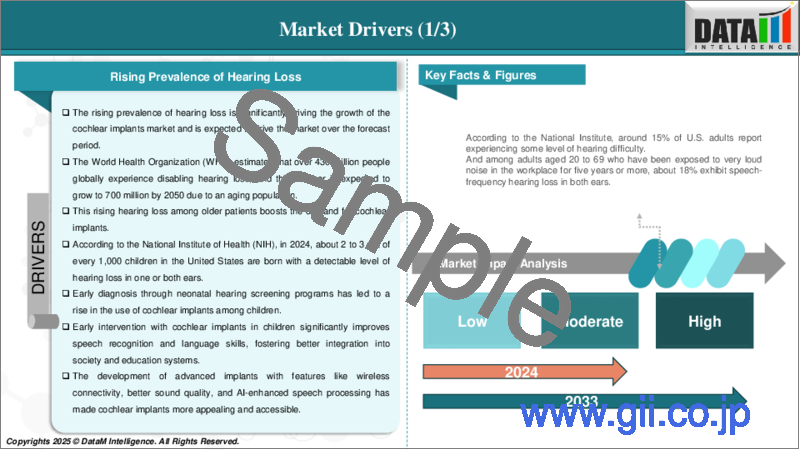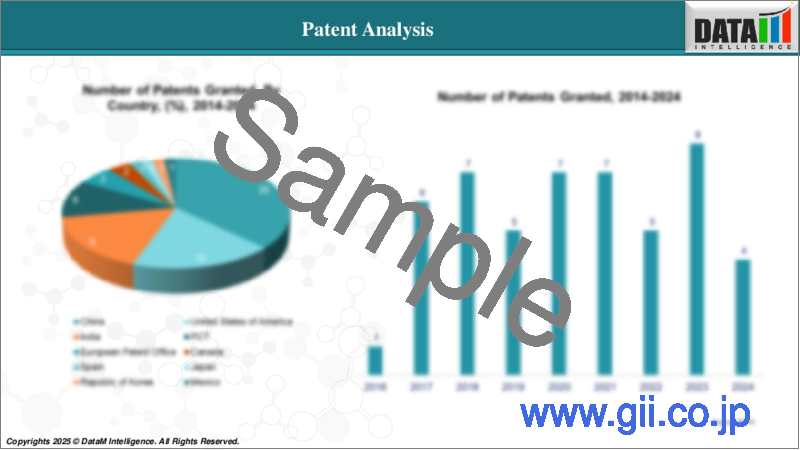|
|
市場調査レポート
商品コード
1634157
人工内耳の世界市場 - 2025~2033年Global Cochlear Implants Market - 2025 - 2033 |
||||||
カスタマイズ可能
適宜更新あり
|
|||||||
| 人工内耳の世界市場 - 2025~2033年 |
|
出版日: 2025年01月13日
発行: DataM Intelligence
ページ情報: 英文 157 Pages
納期: 即日から翌営業日
|
- 全表示
- 概要
- 目次
人工内耳の世界市場は、2024年に19億米ドルに達し、2033年には32億米ドルに達すると予測され、予測期間2025年のCAGRは6.1%で成長します。
人工内耳は、従来の補聴器では十分な効果が得られない重度から高度難聴者に音感を提供するために設計された高度な医療機器です。音を増幅する補聴器とは異なり、人工内耳は内耳の損傷した部分や機能していない部分をバイパスし、聴覚神経を直接刺激して音の信号を脳に伝えます。人工内耳は、重度難聴者に音感を提供し、静かな環境でも騒がしい環境でも、より良い会話の理解を可能にします。
人工内耳市場は、技術の進歩、難聴対策への意識の高まり、人工内耳の世界の普及の高まりにより、近年大きな成長を遂げています。例えば、米国国立衛生研究所(NIH)によると、2022年7月現在、世界中で100万個以上の人工内耳が埋め込まれています。米国では、およそ118,100個が大人に、65,000個が小児に移植されています。子どもの6人に5人は、3歳までに耳の感染症(中耳炎)を経験します。
市場力学:
促進要因と抑制要因
難聴有病率の上昇
難聴の有病率の上昇は、人工内耳市場の成長を大きく後押ししており、予測期間中も市場を牽引していくと予想されます。加齢に伴う難聴は老眼としても知られ、高齢者に最も多い慢性疾患の一つです。世界保健機関(WHO)の推計によると、世界で4億3,000万人以上が障害を伴う難聴を経験しており、高齢化によりこの数は2050年までに7億人に増加すると予想されています。このような高齢者の難聴の増加が、人工内耳の需要を押し上げています。
米国国立衛生研究所(NIH)によると、米国では1,000人の子供のうち約2~3人が、片耳または両耳に検出可能なレベルの難聴を持って生まれてきます。また、18歳以上のアメリカ人成人の約15%(3,750万)が何らかの聴覚障害を訴えています。新生児聴覚スクリーニングプログラムによる早期診断が、子供たちの人工内耳使用率の上昇につながっています。人工内耳による早期介入は、音声認識と言語能力を著しく向上させ、社会や教育システムへのより良い統合を促進します。
ワイヤレス接続、より良い音質、AIによる音声処理などの機能を備えた先進的なインプラントの開発により、人工内耳はより魅力的で利用しやすくなりました。例えば、人工内耳の大手メーカーであるCochlear Limitedは、スマートフォンと互換性のある先進的なサウンドプロセッサを発表し、技術に詳しいユーザーにアピールして普及率を向上させています。
高コストの人工内耳
人工内耳のコストが高いことが、人工内耳市場の成長を妨げると予想されます。人工内耳は、インプラント本体だけでなく、外科手術や術後のケア、リハビリテーションにも多額の投資を必要とするため、多くの個人や家族にとっては手が出せないものとなっています。
例えば、人工内耳は補聴器よりも高価です。人工内耳の平均的な費用は、保険なしで3万ドルから5万ドルです。インドでの人工内耳手術の費用は1500~1万2500ドルですが、米国での手術費用は3万~5万米ドルです。タイの人工内耳手術費用は、片耳あたり約2万~4万米ドルです。この高額な初期費用は、保険や経済的な援助がない患者にとっては大きな障壁となります。
多くの国では、人工内耳に対する保険は一部しか適用されないか、適用されません。開発途上地域では、患者が全費用を負担しなければならないことが多く、高所得者層へのアクセスが制限されています。例えばインドでは、ADIPプログラムのような政府の制度により、子供には無料でインプラントが提供される一方で、補助金の対象とならない成人は経済的なハードルが高く、その結果、導入率が低くなっています。
このレポートの詳細 - サンプル請求
目次
第1章 市場イントロダクションと範囲
- 報告書の目的
- 調査範囲と定義
- 調査範囲
第2章 エグゼクティブの洞察と重要なポイント
- 市場のハイライトと戦略的ポイント
- 主な動向と将来の予測
- タイプ別抜粋
- 年齢層別抜粋
- エンドユーザー別抜粋
- 地域別抜粋
第3章 市場力学
- 影響要因
- 促進要因
- 難聴の罹患率の上昇
- 抑制要因
- 高コストの人工内耳
- 機会
- 影響分析
- 促進要因
第4章 戦略的洞察と業界展望
- 市場のリーダーと先駆者
- 新たな先駆者と著名な企業
- 最大の売上を誇るブランドを確立したリーダー
- 確立された製品を持つ市場リーダー
- CXOの視点
- 最新の開発とブレークスルー
- ケーススタディ/進行中の調査
- 規制と償還の情勢
- 北米
- 欧州
- アジア太平洋地域
- ラテンアメリカ
- 中東・アフリカ
- ポーターのファイブフォース分析
- サプライチェーン分析
- SWOT分析
- アンメットニーズとギャップ
- 市場参入と拡大のための推奨戦略
- シナリオ分析ベストケース、ベースケース、ワーストケースの予測
- 価格分析と価格市場力学
第5章 人工内耳市場、タイプ別
- 片側インプラント
- 両側インプラント
第6章 人工内耳市場、年齢層別
- 大人
- 小児
第7章 人工内耳市場、エンドユーザー別
- 病院
- 専門クリニック
- その他
第8章 人工内耳市場、地域別市場分析と成長機会
- 北米
- 米国
- カナダ
- メキシコ
- 欧州
- ドイツ
- 英国
- フランス
- スペイン
- イタリア
- その他欧州地域
- 南米
- ブラジル
- アルゼンチン
- その他南米
- アジア太平洋地域
- 中国
- インド
- 日本
- 韓国
- その他アジア太平洋地域
- 中東・アフリカ
第9章 競合情勢と市場ポジショニング
- 競合状況の概要と主要な市場企業
- 市場シェア分析とポジショニングマトリックス
- 戦略的パートナーシップ、合併、買収
- 製品ポートフォリオとイノベーションにおける主な発展
- 企業ベンチマーク
第10章 企業プロファイル
- Cochlear Ltd.
- 会社概要
- 製品ポートフォリオと概要
- 財務概要
- 主な発展
- SWOT分析
- Advanced Bionics AG
- MED-EL Medical Electronics
- Oticon Medical A/S
- ZHEJIANG NUROTRON BIOTECHNOLOGY CO., LTD.
- Shanghai Listent Medical TECH Co., Ltd.
- Envoy Medical
第11章 仮定と調査手法
- データ収集方法
- データの三角測量
- 予測技術
- データの検証と検証
第12章 付録
The global cochlear implants market reached US$ 1.9 billion in 2024 and is expected to reach US$ 3.2 billion by 2033, growing at a CAGR of 6.1% during the forecast period 2025-2033.
A cochlear implant is a sophisticated medical device designed to provide a sense of sound to individuals with severe to profound hearing loss who cannot benefit adequately from conventional hearing aids. Unlike hearing aids, which amplify sounds, cochlear implants bypass damaged or non-functional parts of the inner ear and directly stimulate the auditory nerve to deliver sound signals to the brain. Cochlear implants provide a sense of sound for individuals who are profoundly deaf or severely hard of hearing, enable better speech understanding in quiet and noisy environments, allow users to engage in conversations and recognize environmental sounds and offer bilateral implantation for enhanced auditory localization and sound quality.
The cochlear implants market has experienced significant growth in recent years, driven by technological advancements, increased awareness of hearing loss solutions and rising adoption of cochlear implants globally. For instance, according to the National Institute of Health (NIH), as of July 2022, more than 1 million cochlear implants have been implanted worldwide. In the United States, roughly 118,100 devices have been implanted in adults and 65,000 in children. 5 out of 6 children experience ear infections (otitis media) by the time they are 3 years old.
Market Dynamics: Drivers & Restraints
Rising prevalence of hearing loss
The rising prevalence of hearing loss is significantly driving the growth of the cochlear implants market and is expected to drive the market over the forecast period. Age-related hearing loss, also known as presbycusis, is one of the most common chronic conditions in older adults. The World Health Organization (WHO) estimates that over 430 million people globally experience disabling hearing loss, and this number is expected to grow to 700 million by 2050 due to an aging population. These rising hearing loss among older patients boost the demand for cochlear implants.
According to the National Institute of Health (NIH), about 2 to 3 out of every 1,000 children in the United States are born with a detectable level of hearing loss in one or both ears. Approximately 15% of American adults (37.5 million) ages 18 and over report some trouble hearing. Early diagnosis through neonatal hearing screening programs has led to a rise in the use of cochlear implants among children. Early intervention with cochlear implants in children significantly improves speech recognition and language skills, fostering better integration into society and education systems.
The development of advanced implants with features like wireless connectivity, better sound quality, and AI-enhanced speech processing has made cochlear implants more appealing and accessible. For instance, Cochlear Limited, a leading cochlear implant manufacturer, has introduced advanced sound processors compatible with smartphones, appealing to tech-savvy users and improving their adoption rate.
High cost of cochlear implants
The high cost of cochlear implants is expected to hamper the growth of the cochlear implants market. These devices require substantial investment not only for the implant itself but also for the surgical procedure, postoperative care and rehabilitation, making them unaffordable for many individuals and families.
For instance, cochlear implants are more expensive than hearing aids. The average cost of cochlear implants can range from $30,000 to $50,000 without insurance. The cost of Cochlear Implant Surgery in India ranges between USD 1500 to USD 12,500 whereas, the same surgery in the US costs around USD 30,000 to USD 50,000. The Cochlear Implant Surgery Cost In Thailand can range from approximately $20,000 to $40,000 USD per ear. This high upfront cost is a significant barrier for patients without insurance or financial assistance.
In many countries, insurance coverage for cochlear implants is partial or unavailable. Patients in developing regions often have to bear the full cost, limiting access to those from higher income brackets. For instance, in India, while government schemes like the ADIP program provide free implants for children, adults ineligible for subsidies face significant financial hurdles, resulting in low adoption rates.
For more details on this report - Request for Sample
Segment Analysis
The global cochlear implants market is segmented based on type, age group, end-user and region.
Product Type:
The unilateral implants segment is expected to dominate the cochlear implants market share
The unilateral cochlear implants segment is the dominant segment in the cochlear implants market, primarily due to its effectiveness in treating individuals with profound hearing loss in one ear (unilateral hearing loss). This segment is expected to capture the largest market share for several reasons, including cost-effectiveness, surgical simplicity and successful outcomes for patients with single-sided deafness or severe hearing loss in one ear.
Unilateral cochlear implants are widely recommended by otolaryngologists (ENT specialists) and audiologists for patients with single-sided deafness or unilateral severe hearing loss. This wider acceptance in clinical practice has contributed to the dominance of the unilateral implants segment in the cochlear implants market. Thus, the FDA approvals are significantly driving the segment for the cochlear implant market.
For instance, in January 2022, Cochlear Limited, the global leader in implantable hearing solutions, obtained U.S. Food and Drug Administration (FDA) approval of Cochlear Nucleus Implants for the treatment of unilateral hearing loss (UHL)/single-sided deafness (SSD). With this approval, for the first time Cochlear can expand implantable treatment options for those with UHL/SSD to include cochlear implants.
Unilateral hearing loss is a common condition, affecting a significant portion of the population, particularly among children and adults. It may result from congenital factors, infections, accidents, or other health issues. For instance, according to the Cleveland Clinic, experts estimate that 5% of all adults in the U.S. have some form of unilateral hearing loss. Unilateral cochlear implants are the preferred treatment for those who experience severe to profound hearing loss in one ear, allowing them to regain a level of hearing and improve their ability to localize sound, understand speech in noisy environments, and enhance overall communication.
Geographical Analysis
North America is expected to hold a significant position in the cochlear implants market share
North America especially the United States and Canada known for its major market players. Leading cochlear implant manufacturers such as Cochlear Limited, MED-EL, and Advanced Bionics have significant operations in North America, which allows them to leverage the region's advanced healthcare infrastructure for research, development, and product distribution.
The United States has established widespread newborn hearing screening programs, which help in the early detection of hearing impairments in infants. This initiative leads to early cochlear implantation, ensuring better outcomes and driving market growth. For instance, in the United States, the National Institute on Deafness and Other Communication Disorders (NIDCD) promotes awareness about hearing loss and cochlear implants, contributing to higher diagnosis rates and treatment adoption.
There is a rising adoption of cochlear implants in North America, especially in the United States. For instance, according to Statnews, in the United States alone, over two million people could benefit from a cochlear implant.
Major global cochlear implant companies such as Cochlear Limited, MED-EL, and Advanced Bionics have a strong presence in North America, both in terms of sales and research. These companies drive market growth by introducing innovative products and offering comprehensive post-surgery support services. For instance, cochlear Limited, a leader in the cochlear implants market, has its North American headquarters in the U.S., from where it oversees distribution, research, and customer support for its products across North America.
Asia-Pacific is growing at the fastest pace in the cochlear implants market
As the economies of several Asia-Pacific countries, especially China and India, continue to grow, more people are able to afford cochlear implants. The middle class in these countries is expanding, and with this comes increased spending on healthcare. The cost of cochlear implants in the APAC region is often lower compared to Western markets, partly due to local manufacturing and government subsidies, making them more accessible to a wider population.
For instance, the cost of Cochlear Implant Surgery in India ranges between USD 1500 to USD 12,500 whereas, the same surgery in the US costs around USD 30,000 to USD 50,000. This cost affordability helps reduce the cost burden and increases market penetration in both urban and rural areas.
In China and India, cochlear implants are seeing increasing adoption, driven by high levels of unmet need, improving awareness, and government support for healthcare initiatives. In these emerging markets, cochlear implant procedures are being funded through public health programs, making them accessible to economically disadvantaged populations. For instance, the Indian government's Assistance to Disabled Persons (ADIP) scheme offers free cochlear implants for children from economically weaker sections, significantly increasing access to implants.
Competitive Landscape
The major global players in the cochlear implants market include Cochlear Ltd., Advanced Bionics AG, MED-EL Medical Electronics, Oticon Medical A/S, ZHEJIANG NUROTRON BIOTECHNOLOGY CO., LTD., Shanghai Listent Medical TECH Co., Ltd., Envoy Medical and among others.
Why Purchase the Report?
- Pipeline & Innovations: Reviews ongoing clinical trials, product pipelines, and forecasts upcoming advancements in medical devices and pharmaceuticals.
- Product Performance & Market Positioning: Analyzes product performance, market positioning, and growth potential to optimize strategies.
- Real-World Evidence: Integrates patient feedback and data into product development for improved outcomes.
- Physician Preferences & Health System Impact: Examines healthcare provider behaviors and the impact of health system mergers on adoption strategies.
- Market Updates & Industry Changes: Covers recent regulatory changes, new policies, and emerging technologies.
- Competitive Strategies: Analyzes competitor strategies, market share, and emerging players.
- Pricing & Market Access: Reviews pricing models, reimbursement trends, and market access strategies.
- Market Entry & Expansion: Identifies optimal strategies for entering new markets and partnerships.
- Regional Growth & Investment: Highlights high-growth regions and investment opportunities.
- Supply Chain Optimization: Assesses supply chain risks and distribution strategies for efficient product delivery.
- Sustainability & Regulatory Impact: Focuses on eco-friendly practices and evolving regulations in healthcare.
- Post-market Surveillance: Uses post-market data to enhance product safety and access.
- Pharmacoeconomics & Value-Based Pricing: Analyzes the shift to value-based pricing and data-driven decision-making in R&D.
The global Cochlear Implants market report delivers a detailed analysis with 53 key tables, more than 47 visually impactful figures, and 157 pages of expert insights, providing a complete view of the market landscape.
Target Audience 2024
- Manufacturers: Pharmaceutical, Medical Device, Biotech Companies, Contract Manufacturers, Distributors, Hospitals.
- Regulatory & Policy: Compliance Officers, Government, Health Economists, Market Access Specialists.
- Technology & Innovation: AI/Robotics Providers, R&D Professionals, Clinical Trial Managers, Pharmacovigilance Experts.
- Investors: Healthcare Investors, Venture Fund Investors, Pharma Marketing & Sales.
- Consulting & Advisory: Healthcare Consultants, Industry Associations, Analysts.
- Supply Chain: Distribution and Supply Chain Managers.
- Consumers & Advocacy: Patients, Advocacy Groups, Insurance Companies.
- Academic & Research: Academic Institutions.
Table of Contents
1. Market Introduction and Scope
- 1.1. Objectives of the Report
- 1.2. Report Coverage & Definitions
- 1.3. Report Scope
2. Executive Insights and Key Takeaways
- 2.1. Market Highlights and Strategic Takeaways
- 2.2. Key Trends and Future Projections
- 2.3. Snippet by Type
- 2.4. Snippet by Age Group
- 2.5. Snippet by End-User
- 2.6. Snippet by Region
3. Dynamics
- 3.1. Impacting Factors
- 3.1.1. Drivers
- 3.1.1.1. Rising Prevalence of Hearing Loss
- 3.1.2. Restraints
- 3.1.2.1. High Cost of the Cochlear Implants
- 3.1.3. Opportunity
- 3.1.4. Impact Analysis
- 3.1.1. Drivers
4. Strategic Insights and Industry Outlook
- 4.1. Market Leaders and Pioneers
- 4.1.1. Emerging Pioneers and Prominent Players
- 4.1.2. Established leaders with largest selling Brand
- 4.1.3. Market leaders with established Product
- 4.2. CXO Perspectives
- 4.3. Latest Developments and Breakthroughs
- 4.4. Case Studies/Ongoing Research
- 4.5. Regulatory and Reimbursement Landscape
- 4.5.1. North America
- 4.5.2. Europe
- 4.5.3. Asia Pacific
- 4.5.4. Latin America
- 4.5.5. Middle East & Africa
- 4.6. Porter's Five Force Analysis
- 4.7. Supply Chain Analysis
- 4.8. SWOT Analysis
- 4.9. Unmet Needs and Gaps
- 4.10. Recommended Strategies for Market Entry and Expansion
- 4.11. Scenario Analysis: Best-Case, Base-Case, and Worst-Case Forecasts
- 4.12. Pricing Analysis and Price Dynamics
5. Cochlear Implants Market, By Type
- 5.1. Introduction
- 5.1.1. Market Size Analysis and Y-o-Y Growth Analysis (%), By Type
- 5.1.2. Market Attractiveness Index, By Type
- 5.2. Unilateral Implants*
- 5.2.1. Introduction
- 5.2.2. Market Size Analysis and Y-o-Y Growth Analysis (%)
- 5.3. Bilateral Implants
6. Cochlear Implants Market, By Age Group
- 6.1. Introduction
- 6.1.1. Market Size Analysis and Y-o-Y Growth Analysis (%), By Age Group
- 6.1.2. Market Attractiveness Index, By Age Group
- 6.2. Adults*
- 6.2.1. Introduction
- 6.2.2. Market Size Analysis and Y-o-Y Growth Analysis (%)
- 6.3. Pediatrics
7. Cochlear Implants Market, By End-User
- 7.1. Introduction
- 7.1.1. Market Size Analysis and Y-o-Y Growth Analysis (%), By End-User
- 7.1.2. Market Attractiveness Index, By End-User
- 7.2. Hospitals*
- 7.2.1. Introduction
- 7.2.2. Market Size Analysis and Y-o-Y Growth Analysis (%)
- 7.3. Specialty Clinics
- 7.4. Others
8. Cochlear Implants Market, By Regional Market Analysis and Growth Opportunities
- 8.1. Introduction
- 8.1.1. Market Size Analysis and Y-o-Y Growth Analysis (%), By Region
- 8.1.2. Market Attractiveness Index, By Region
- 8.2. North America
- 8.2.1. Introduction
- 8.2.2. Key Region-Specific Dynamics
- 8.2.3. Market Size Analysis and Y-o-Y Growth Analysis (%), By Type
- 8.2.4. Market Size Analysis and Y-o-Y Growth Analysis (%), By Age Group
- 8.2.5. Market Size Analysis and Y-o-Y Growth Analysis (%), By End-User
- 8.2.6. Market Size Analysis and Y-o-Y Growth Analysis (%), By Country
- 8.2.6.1. U.S.
- 8.2.6.2. Canada
- 8.2.6.3. Mexico
- 8.3. Europe
- 8.3.1. Introduction
- 8.3.2. Key Region-Specific Dynamics
- 8.3.3. Market Size Analysis and Y-o-Y Growth Analysis (%), By Type
- 8.3.4. Market Size Analysis and Y-o-Y Growth Analysis (%), By Age Group
- 8.3.5. Market Size Analysis and Y-o-Y Growth Analysis (%), By End-User
- 8.3.6. Market Size Analysis and Y-o-Y Growth Analysis (%), By Country
- 8.3.6.1. Germany
- 8.3.6.2. U.K.
- 8.3.6.3. France
- 8.3.6.4. Spain
- 8.3.6.5. Italy
- 8.3.6.6. Rest of Europe
- 8.4. South America
- 8.4.1. Introduction
- 8.4.2. Key Region-Specific Dynamics
- 8.4.3. Market Size Analysis and Y-o-Y Growth Analysis (%), By Type
- 8.4.4. Market Size Analysis and Y-o-Y Growth Analysis (%), By Age Group
- 8.4.5. Market Size Analysis and Y-o-Y Growth Analysis (%), By End-User
- 8.4.6. Market Size Analysis and Y-o-Y Growth Analysis (%), By Country
- 8.4.6.1. Brazil
- 8.4.6.2. Argentina
- 8.4.6.3. Rest of South America
- 8.5. Asia-Pacific
- 8.5.1. Introduction
- 8.5.2. Key Region-Specific Dynamics
- 8.5.3. Market Size Analysis and Y-o-Y Growth Analysis (%), By Type
- 8.5.4. Market Size Analysis and Y-o-Y Growth Analysis (%), By Age Group
- 8.5.5. Market Size Analysis and Y-o-Y Growth Analysis (%), By End-User
- 8.5.6. Market Size Analysis and Y-o-Y Growth Analysis (%), By Country
- 8.5.6.1. China
- 8.5.6.2. India
- 8.5.6.3. Japan
- 8.5.6.4. South Korea
- 8.5.6.5. Rest of Asia-Pacific
- 8.6. Middle East and Africa
- 8.6.1. Introduction
- 8.6.2. Key Region-Specific Dynamics
- 8.6.3. Market Size Analysis and Y-o-Y Growth Analysis (%), By Type
- 8.6.4. Market Size Analysis and Y-o-Y Growth Analysis (%), By Age Group
- 8.6.5. Market Size Analysis and Y-o-Y Growth Analysis (%), By End-User
9. Competitive Landscape and Market Positioning
- 9.1. Competitive Overview and Key Market Players
- 9.2. Market Share Analysis and Positioning Matrix
- 9.3. Strategic Partnerships, Mergers & Acquisitions
- 9.4. Key Developments in Product Portfolios and Innovations
- 9.5. Company Benchmarking
10. Company Profiles
- 10.1. Cochlear Ltd.*
- 10.1.1. Company Overview
- 10.1.2. Product Portfolio and Description
- 10.1.3. Financial Overview
- 10.1.4. Key Developments
- 10.1.5. SWOT Analysis
- 10.2. Advanced Bionics AG
- 10.3. MED-EL Medical Electronics
- 10.4. Oticon Medical A/S
- 10.5. ZHEJIANG NUROTRON BIOTECHNOLOGY CO., LTD.
- 10.6. Shanghai Listent Medical TECH Co., Ltd.
- 10.7. Envoy Medical
LIST NOT EXHAUSTIVE
11. Assumption and Research Methodology
- 11.1. Data Collection Methods
- 11.2. Data Triangulation
- 11.3. Forecasting Techniques
- 11.4. Data Verification and Validation
12. Appendix
- 12.1. About Us and Services
- 12.2. Contact Us






